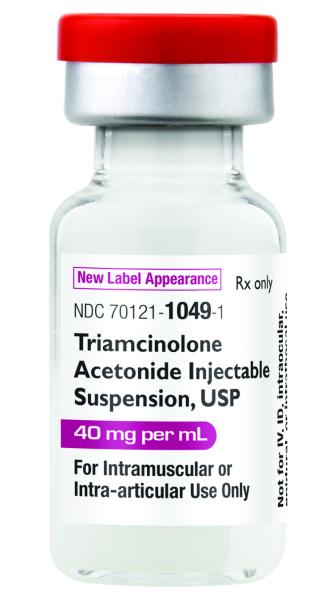Triamcinolone Interactions
There are 622 drugs known to interact with triamcinolone, along with 23 disease interactions, and 2 alcohol/food interactions. Of the total drug interactions, 108 are major, 479 are moderate, and 35 are minor.
- View all 622 medications that may interact with triamcinolone
- View triamcinolone alcohol/food interactions (2)
- View triamcinolone disease interactions (23)
Most frequently checked interactions
View interaction reports for triamcinolone and the medicines listed below.
- Aspirin Low Strength (aspirin)
- Benadryl (diphenhydramine)
- Claritin (loratadine)
- CoQ10 (ubiquinone)
- Cymbalta (duloxetine)
- Eliquis (apixaban)
- Fish Oil (omega-3 polyunsaturated fatty acids)
- Flonase (fluticasone nasal)
- Lasix (furosemide)
- Lyrica (pregabalin)
- Metoprolol Succinate ER (metoprolol)
- Metoprolol Tartrate (metoprolol)
- MiraLAX (polyethylene glycol 3350)
- Mucinex (guaifenesin)
- Nexium (esomeprazole)
- Norco (acetaminophen / hydrocodone)
- Ozempic (semaglutide)
- ProAir HFA (albuterol)
- Probiotic Formula (bifidobacterium infantis / lactobacillus acidophilus)
- Singulair (montelukast)
- Symbicort (budesonide / formoterol)
- Synthroid (levothyroxine)
- Tylenol (acetaminophen)
- Ventolin HFA (albuterol)
- Vitamin B12 (cyanocobalamin)
- Vitamin C (ascorbic acid)
- Vitamin D2 (ergocalciferol)
- Vitamin D3 (cholecalciferol)
- Zofran (ondansetron)
- Zyrtec (cetirizine)
Triamcinolone alcohol/food interactions
There are 2 alcohol/food interactions with triamcinolone.
Triamcinolone disease interactions
There are 23 disease interactions with triamcinolone which include:
- infections
- prematurity
- (+) tuberculin test
- cirrhosis
- depression/psychoses
- diabetes
- electrolyte imbalance
- fluid retention
- GI perforation
- hyperadrenocorticalism
- hyperlipidemia
- hypothyroidism
- liver disease
- MI
- myasthenia gravis
- myopathy
- ocular herpes simplex
- ocular toxicities
- osteoporosis
- PUD
- scleroderma
- strongyloidiasis
- thromboembolism
More about triamcinolone
- triamcinolone consumer information
- Compare alternatives
- Pricing & coupons
- Reviews (230)
- Drug images
- Side effects
- Dosage information
- During pregnancy
- Support group
- Drug class: glucocorticoids
- Breastfeeding
Related treatment guides
Drug Interaction Classification
| Highly clinically significant. Avoid combinations; the risk of the interaction outweighs the benefit. | |
| Moderately clinically significant. Usually avoid combinations; use it only under special circumstances. | |
| Minimally clinically significant. Minimize risk; assess risk and consider an alternative drug, take steps to circumvent the interaction risk and/or institute a monitoring plan. | |
| No interaction information available. |
See also:
Further information
Always consult your healthcare provider to ensure the information displayed on this page applies to your personal circumstances.


